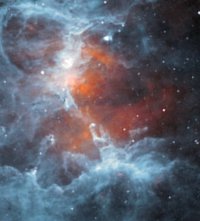Protostars
Protostars and Nebulae
Although Space may seem empty, it is actually full of thinly spread gas and dust. This gas and dust is called interstellar medium. The gas is mostly made up of atoms of hydrogen, though small amounts of heavier elements can be found floating through space, as well.

In some places, the interstellar medium is collected into a big cloud of dust and gas called a nebula. A nebula can be many light years across. It is in these nebulae that dust and gas can come together to form stars. A star is not truly a star until it can fuse hydrogen into helium. Before that, they are called Protostars. A protostar is formed as gravity begins to pull the gases together into a ball. This process is known as accretion.
As gravity pulls the gasses closer to the center of the ball, gravitational energy begins to heat them, causing the gasses to emit radiation. At first, the radiation simply escapes into space. However, as the protostar pulls in matter and gets more dense, much of the radiation becomes trapped inside, heating the protostar even more quickly.
If the protostar can reach a temperature of 10 million degrees kelvin, the hydrogen fusion process will start and it will become an actual star. These stars which have successfully managed to start hydrogen fusion appear on the Hertzsprung-Russel Diagram in an area known as the Main Sequence, which is where stars spend most of their life cycle.
Brown Dwarfs
Some protostars never get hot enough to start the hydrogen fusion process. These are known as Brown Dwarfs. Brown Dwarfs are generally smaller than our sun, but larger than the planet Jupiter. Even though they aren't considered real stars, they continue to shine dimly for millions of years as they cool down.
Deuterium Burning
Even though protostars can't fuse normal hydrogen atoms, they can fuse deuterium. Deuterium is a rare form of hydrogen that has both a proton and a neutron in its nucleus. Deuterium is much easier to fuse than normal hydrogen, so both protostars and some brown dwarfs are able to fuse it into helium.
Deuterium burning is important in protostars because the reaction keeps the temperature inside at a constant 1 million degrees, like a stellar thermostat. Since normal hydrogen fusion doesn't occur until 10 million degrees, it will remain a protostar longer, accreting more matter and becoming a more massive star.